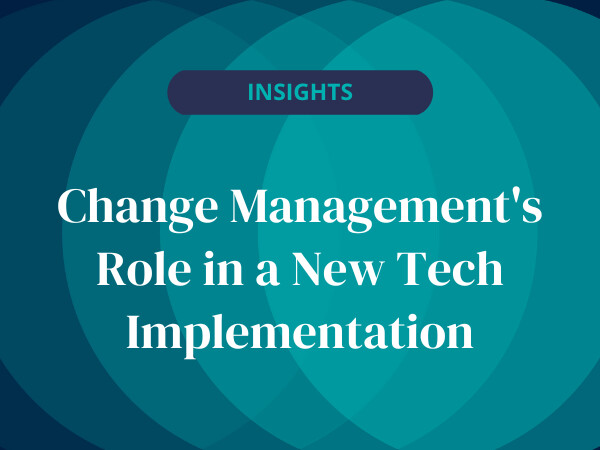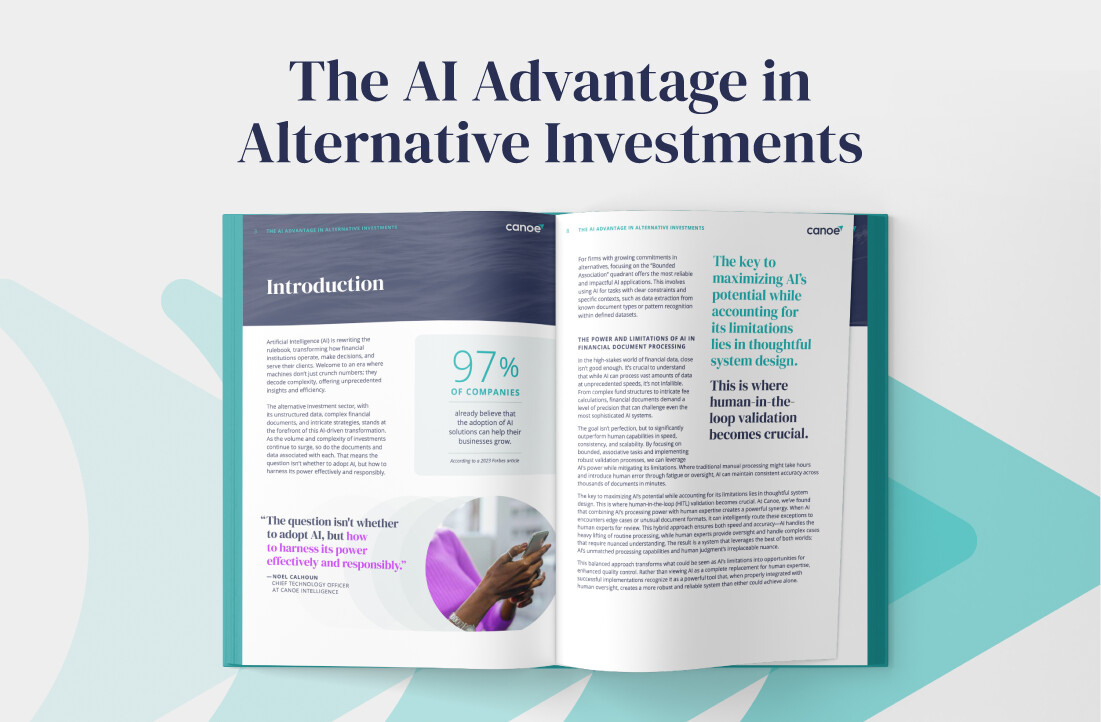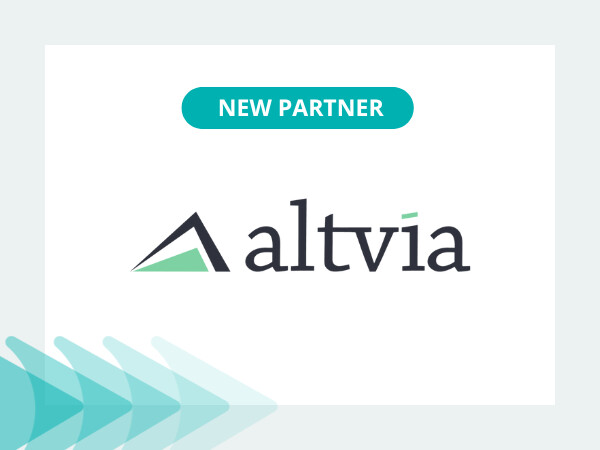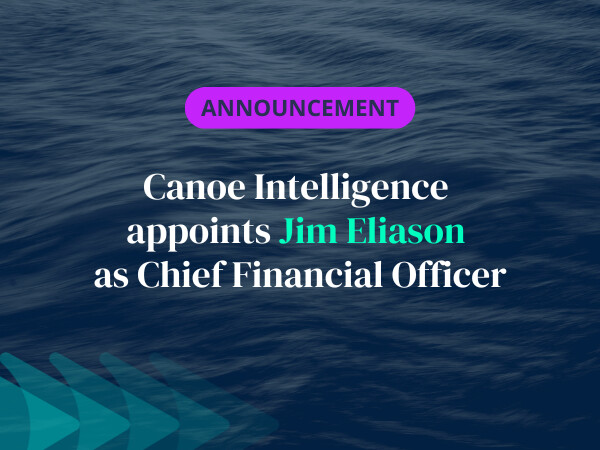How Much of Your Operations Should You Actually Automate?
Canoe Thought Starters is a blog series that explores timely topics for single-family offices, multi-family offices, registered investment advisors, and private banks. These discussions are inspired by our recent conversations with clients, prospects, and influencers in the industry. These blogs are designed as thought exercises to drive conversations within your firm, and this month we are focused on questions to consider when automating alternative investment operations within a wealth management firm.
Table of Contents:
- Considering Automation
- The Canoe Optimized Workflow: The Tasks That Can and Should Be Automated
- The Real Secret to Automation is Adoption
Considering Automation
There is no denying that back-office processing work is a necessary part of a wealth manager’s business, but it is also no secret that this work is tedious, monotonous, and time-consuming when performed manually. With capital allocation to alternative investments continuing to trend upward, the operational burden associated with managing the documents from multiple sources also increases due to the added complexity brought on by alternatives. Tasks crucial to the wealth manager, such as document and data management, do not drive scale, boost performance, or differentiate the firm. Yet, firms often invest heavily in teams to perform these operations manually. To begin driving value in these areas, the best path forward is to explore automating these processes — and we will discuss the best ways to do so below.
Over the last decade, automation has gone from a buzzword to table stakes. As seen by the increased prevalence of financial technology firms, the finance industry is no exception to this rule. However, despite the progress made by these tech firms, many wealth managers remain hesitant towards automation and therefore slow to adopt the solutions available to them. Fortunately, these roadblocks are ones that can be overcome prior to implementation. Choosing a specific, high-impact area for an initial automation program, and then providing education about the power of that purpose-built solution serves to build trust in automation to handle these workflows appropriately.
For multi-family offices (MFOs), in particular, the value proposition of automation is rather simple. As MFOs grow in popularity, the factors that differentiate them all stand to benefit. Automation helps an MFO further reduce overhead expenses by introducing additional economies of scale. The deeper access to data for analysis and reporting drives increased objectivity in investment decision-making. Improvement in these areas also contributes to a superior negotiation capacity when exploring new investment deals. Modern investors are more likely to take a diverse, global approach to their investment interests, resulting in a higher rate of investment in alternatives. As a family grows, the structure of their office’s investments naturally becomes more complex to support the differing objectives of each individual member. Though alternative investments typically bring more complexity and additional processing requirements, by automating these workflows, the office can maintain and grow its competitive advantage.
The Canoe Optimized Workflow: The Tasks That Can and Should Be Automated
Beyond exploring new automated technologies for potential implementation, wealth management firms should look to those providers that design purpose-built technology, as in those who are specifically focused on alternative investments as opposed to general purpose, one-size-fits-all solutions. Taking the deep industry expertise of our team into account, Canoe has defined the following Optimized Workflow as a model for wealth managers looking to improve their alternatives document and data management processes.
Portal Connectivity & Document Collection
The first step of any document and data management process is always the same: every organization needs to access and gather all of its documents. However, these documents are prepared by different parties, shared from multiple sources, presented in different formats, and received at varying frequencies. There is little standardization across document structures and therefore no reliable way to extract data from them. This process can be one of the most time-consuming tasks for a firm with a large alternatives platform, with some organizations spending thousands of hours a year simply retrieving documents and triaging email inboxes. One missing or improperly named document can delay the entire workflow.
Questions to Ask:
- Document Sourcing – Where are my documents located? How many portals, email inboxes, and other sources do my team need to manage as a result?
- Time Requirements – How efficiently can we access all of these documents? How long does this take each month? How much time could we save if this process were automated?
- Operational Obstacles – Does my organization ever struggle to access documents due to credential issues, document storage disparities, or inconsistent file naming? How does this impact our downstream processes? Could we manage this more securely?
Document Ingestion
Once collected, these documents need to be ingested and categorized to be used by your firm. Account statements, call notices, distribution notices, K-1s, quarterly letters, hedge fund factsheets, and other document types all provide different pieces of information and are prepared at varying cadences. When processed manually, each document requires a detailed, page-by-page review in order to locate the pertinent information and then type it into the internal database. It is not uncommon for wealth managers to build out entire teams whose exclusive focus is to collect, ingest, and review documents from each source, but that is not a sustainable practice, especially given the complicated nature of alternative investments.
Questions to Ask:
- Duplicative Effort – Are my front and back office teams performing duplicative tasks?
- Document Identification – How does my firm identify high-priority documents? How do we know when these are received? How do we know when they are late or missing?
- Timeliness – How much does a missing document affect our ability to service clients? Do we often deliver reports late because we don’t yet have access to relevant data?
- Downstream Impacts – Are our downstream processes delayed because our operations team needs to spend significant time collecting and ingesting key information? How much would a change here benefit the rest of our business?
Document Categorization
Once documents are ingested, wealth managers need to categorize and understand what they are before taking action. For firms with thousands or millions of documents, this is a daunting task. Most commonly, the company will build teams to process the documents – analyze, read, and categorize them by client, legal entity, document type, or date – and do this all manually. Some notices require immediate action, but that isn’t exactly possible when thousands of documents require processing. On top of that, the more individuals managing this process, the less standardized it can become – different employees may categorize documents differently or use different naming conventions, leading to significant negative downstream impacts across the organization due to an inability to access information needed in a timely manner.
Questions to Ask:
- Standardization – Do we enforce a standardized internal naming convention? If so, how consistently and diligently are we applying it?
- Storage Repository – Where does my team store documents? Do different teams store the same files in different places? Is there a way to better organize and centralize this?
- Security Measures – Do we have adequate document security controls to protect our most sensitive data?
- Miscategorization – How often do we struggle to locate documents or “miss” them completely? How much time is this costing my team on a monthly basis?
Data Extraction
Once documents are collected and categorized into a repository, wealth managers need to extract the data elements and save the parsed information for downstream use. Traditionally, this process is performed entirely manually as data could differ depending on the document type and the manager, and often that data is reported in significantly disparate ways across managers and documents. These complexities make it a challenge to automate the extraction of relevant information using generic data capture tools or OCR solutions. Thus, it is not uncommon for firms to build large teams, sometimes offshore, to perform these extraction tasks. However, this quickly grows unsustainable, especially when dealing with alternatives, and does not set a strong foundation for the organization’s future growth.
Questions to Ask:
- Resource Optimization – How long does it take us to capture and input data for our reporting and accounting workflows each quarter? Are our professionals doing this extraction and data entry work manually?
- Capacity Constraints – Are we limited in the data we can gather from documents due to capacity constraints? Are there other data exercises we’d like to take on but never seem to have enough time or resources for?
- Data Access – Can we access critical data points needed to deliver relevant alternative investment reporting? Can we leverage historical data in support of new initiatives?
Data Validation
In a typical extraction workflow, wealth managers not only need to extract and access the data but actually need to reconcile and validate that this data is accurate within the context of the particular investment or document type. You may need to ensure that the beginning balance matches the prior period’s ending balance, or that the net return that is reported on a manager’s statement matches what is calculated based on the ending balance, beginning balance, and intra-period flows. This must be done at scale and as quickly as possible to push this data into your downstream systems with 100% confidence. While tedious, this validation step is critical to ensure data integrity and quality as part of this workflow. When performed manually, elaborate, expensive processes require maker-checker or double-blind entry controls to reconcile and verify the data associated with alternative investments. These steps can be time-consuming, significantly cost-prohibiting, and error-prone.
Questions to Ask:
- Future-Proofing – How sustainable are my firm’s validation and reconciliation workflows given our current and future expected volumes? Does the size of our team have a major impact on our ability to explore new investments and scale our business?
- Operational Efficiency – How large of a team is needed to reconcile our data and identify discrepancies? What is our accuracy rate? Are we consistently catching the same issues? How long does it take on average between identification and resolution?
- Downstream Challenges – How much confidence does our team have in the quality of our data? What impact does poor data quality have on our downstream reporting systems? How much time does our team spend resolving downstream issues?
Data Delivery
The last step, and perhaps the most critical, is the delivery of this data into the downstream systems that need it for analysis. These can include performance systems, accounting systems, or internal data warehouses. Historically, the process of normalizing data across millions of data points into a format that can feed various downstream systems has been challenging and manual, requiring numerous translation steps. Similar to the ingestion process, duplicative work often occurs to push relevant data in specialized formats to these disparate locations.
Questions to Ask:
- Connectivity – Do we have the connectivity we need for reporting, analytics, and accounting systems to be as effective as possible? Are we able to feed our clean data seamlessly into the systems?
- Disparate Formats – Are we manually formatting data to feed multiple downstream systems? How many different reporting formats are required by our downstream partners? How many steps does it take to populate each different report format?
- Report Deliverability – How many different client report types does our team have to manage each cycle? Is the right data getting to the right people in the right formats?
The Real Secret to Automation is Adoption
Ultimately, automation is becoming a key factor in building a competitive advantage. In times of economic uncertainty, operational excellence is especially important. Your ability to keep costs predictable through a competitive labor market and volatile investment trends ensures your path to success. However, many of the manual processes in the traditional document and data management workflow are not sustainable without automation.
By introducing automation, you set up a stronger foundation for growth and create a more scalable infrastructure. Rather than allow operations to limit your growth, fully automating your back office increases your capacity to move forward with growth initiatives – particularly with newer, exciting investments, often in alternatives – and helps your company to better serve your clients. With all document and data management processes being handled by the technology, your team unlocks additional, deeper access to data across your organization. The full transparency into your data and increased capacity to undertake research initiatives lead to the ability to generate investment insights with more confidence.
With the introduction of automated solutions for alternative investment operations, like Canoe Intelligence, also comes the opportunity to completely transform these manual workflows and bring more standardization into the financial industry. The results from an automated document and data management system implementation are immediate and undeniable. For example, according to our proprietary research, firms without Canoe allocate one individual to manage 250 investments. With Canoe, that same individual can easily manage over 5,000 investments.
The platform-agnostic approach taken by a provider like Canoe produces significant economies of scale in the document and data management process. The software handles the end-to-end workflow on your behalf, providing you with a single, centralized data hub and freeing up your team’s capacity. Learn more about Canoe: https://canoeintelligence.com/products/




